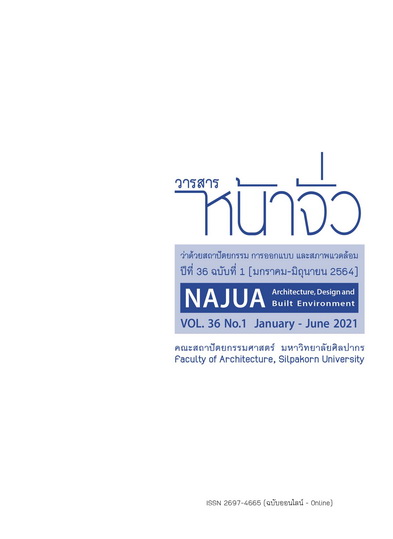“Entryway” The meaning of the transition sequence
Keywords:
Entryway, Meaning and perception, Threshold spaces, Sequence of transitionAbstract
“Entryway”, the starting point for perception and an important element of architecture in which time sequences between humans move with sensory perception. From the outside area into the indoor area, it creates implications, creates situations, organizes controlled spaces, and provides freedom of access. To create an atmosphere of perception of new experiences that are different from the original human habitation.
This review article aims to explore the meanings, functions, methods, and factors affecting the formation of entrance areas in architecture. To lead to the continuation of the complete thesis study on the topic “Main entrance relationship of visual body movement and proportions in architecture”. By using analytical methods from literature and related research. The content hierarchy was divided into 4 parts: 1) the meaning of the entryway 2) the entryway and the zoning area 3) the zoning area and the transition sequence 4) the perception of the entryway area.
The conclusion at the end of the article shows that the definition of the entryway today is often based on an “intercept, slow down” method with a number of sequential boundaries. And can separate the entryway area into 5 parts, namely the entryway of the project area, the area before the entryway, the entryway to the building and the area behind the entryway to the building. In order to bring the conclusions for further analysis of the complete thesis.
References
Ando, T. (2017). Tadao Ando: Endeavors, 安藤忠雄展:挑戦 , Tadao Ando Exhibition Committee, and The National Art Center, Tokyo, eds. Tadao Ando: Endeavors. Tadao Ando Exhibition Committee, 2017. International Printing Publishing Laboratory Co.,Ltd: Tadao Ando Exhibition Committee (Japan).
Boettger, T. (2014). Threshold Spaces. Boston: Birkhäuser.
Carol Davidson Cragoe , H. P. (2008). How to read buildings a crash course in architecture. Great Britain
Christopher, D. (2020). Places of the Soul: Architecture and Environmental Design as a Healing Art. (S. Kunthiworapong, Trans. Vol. 1). BKK: PabPim Company.
Fujimoto, S. (2008). The Impact of Threshold in Phenomenological Architecture The Impact of Threshold in Phenomenological Architecture :House. N. (2008), Oita: Sou Fujimoto Architects.
Jirathatsanakul, S. (2003). Kati Sanyaluck Lae Kwammaikhong "Shumphatoo-Natang" Thai (In Thai). BKK: Amarin printting and publishing.
Panin, T. (2020). ART-I-FACT. BKK: Li-zen.
Psarra, S. (2009). Architecture and narrative the formation of space and culture meaning. Abingdon: Routledge Taylor & Francis Group.
Slessor, C. (2002). Contemporary Doorways Architectural entrances, Transitions and Thresholds. London: Octopus Publishing Group.
Srisaowanunt, A., & Inpuntung, V. (2016). “Concept of Place and Phenomenology in the study of Vernacular Architecture”. Academic Journal: Faculty of Architecture, Khon Kaen University, 15(1), 20.
Studio, S. C. (2018). A History of Thresholds life, death & rebirth. Berlin: Jovis Verlag GmbH.
Tawayuttawong, C. 2018). 9 Things You Must Know: The Pantheon. Gypzy world Civilization. Retrieved from https://bit.ly/3KrEzT0
Unwin, S. (2007). Doorway. Abingdon: Routledge Taylor & Francis Group.
Zumthor, P. (2018). PETER ZUMTHOR ATMOSPHERES Architectural Environments, Surrounding Objects. A lecture. delivered on 1 June 2003 at the (Kunstscheune), Wendinghausen Castle, (Wege durch das land) Festival of Literature and Music in East-Westphalia-Lippe (W. Lain Galbraith, Trans.). Berlin: Birkhäuser.
武,中., & Nakagawa, T. (2019). The Japanese House: In Space, Memory and Language. (Thai Version) (C. Isavorapant, Trans.). BKK: Taweewat publishing.
Downloads
Published
How to Cite
Issue
Section
License

This work is licensed under a Creative Commons Attribution-NonCommercial-NoDerivatives 4.0 International License.




